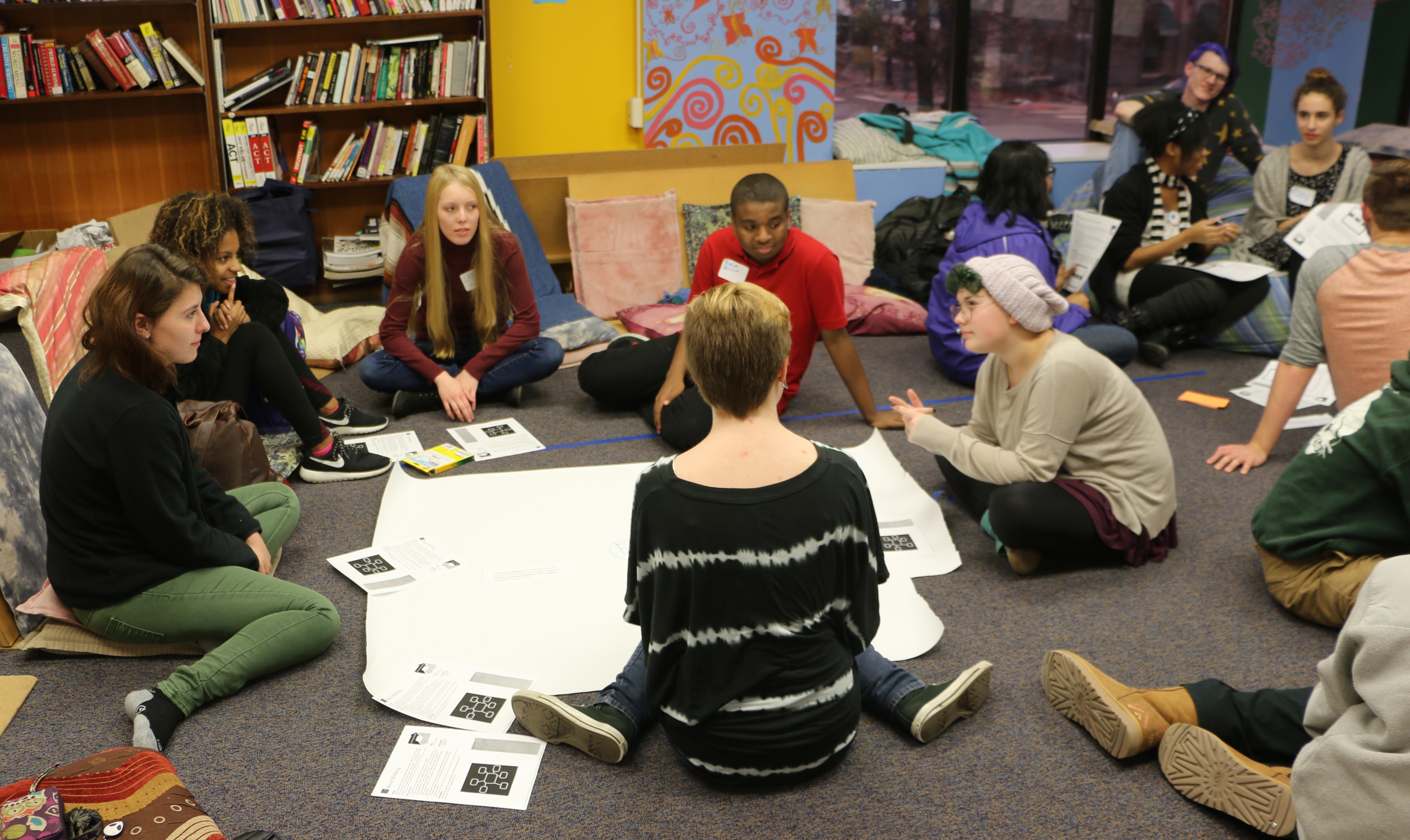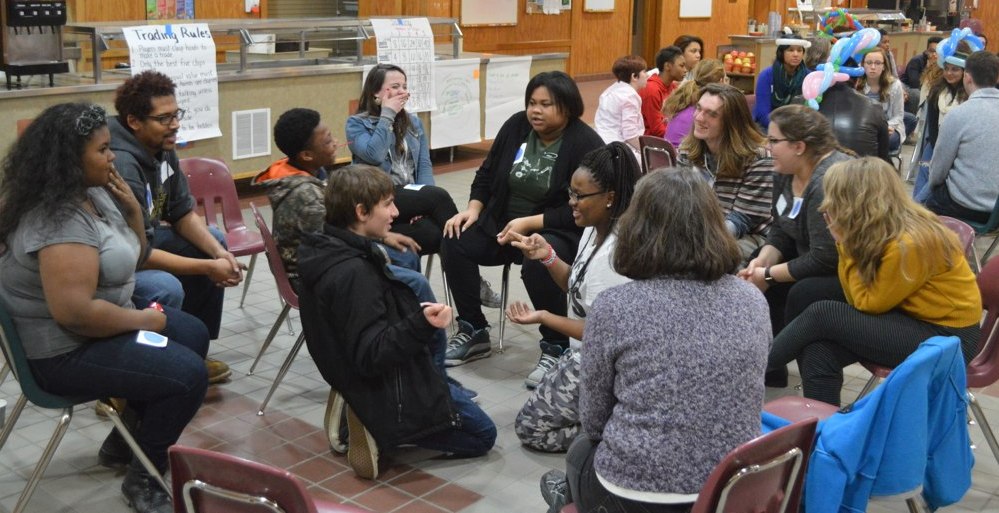
Since 2018, Professional Programs and Training (PPAT) has partnered with Ann Arbor’s Neutral Zone to offer innovative training programs focused on fostering positive relationships between teachers and students to K-12 educators.
The partnership between these two historic organizations continues with Virtual Introduction to Restorative Practices & Circles and Training of Trainers in Restorative Practices and Circles*.
These 2-day and 3-day courses, respectively, will be taught by John Weiss, the Director of Strategic Initiatives at the Neutral Zone. The introductory course provides the theoretical grounding for Restorative Practices (RP), applied strategies and practices to effectively implement RP, as well as an introduction to the history of RP, as it relates to indigenous and native peoples.
What are Restorative Practices?
Restorative Practices is a unique approach to engaging with students which builds social capital amongst a community, gives youth voice, and achieves social discipline through participatory learning and decision making. These practices help reduce bullying, improve human behavior, strengthen civil society, provide effective leadership, restore relationships, and repair harm.
“Education is hard work,” John Weiss says. “Being a classroom teacher and trying to support 25 different minds, interests, identities and abilities has always been a challenge for educators. Layered on top of the fundamental challenges of providing effective teaching and learning to serve a diverse body of students are the enormous challenges students carry with them to school. These include food and housing insecurity, emotional stress and trauma, mental and physical health challenges, or the myriad of other risk factors that all children face. Schools are asked to do much more to just prepare children to be ready for teaching and learning.”
The origins of Restorative Practices date back to ancient times and communities where the practice of sharing stories, thoughts, and feelings around a fire was commonplace. The idea of building community in a shared space is one of the foundations of RP.
As opposed to the rows of a traditional classroom, a circle creates a more personal environment. Students and teachers are face to face with each other, which allows emotions to be more easily read and an openness that creates accountability.
While Restorative Practices can be used as an alternative to typical forms of punishment in education, ideally it is used to prevent the need for such actions. "Settings that use this sort of practice should be employing it 80% of the time for proactive reasons and then 10 to 20% of the time as reactive to repair harm," John Weiss says.
Circles help foster a sense of belonging that makes it less likely for the people in communities to harm each other, but when they do - it can be an effective tool to repair the harm done.
In an interview with the International Institute of Restorative Practices, Robert Yazzie a Chief Justice of the Navajo Supreme Court explained how repairing harm is handled in Navajo communities, “For example, let’s say you and I got into a squabble, and you hit me over the head. In the Western world, you would be called a defendant in a criminal proceeding and would create a bad name for yourself. The Western law way is to punish you, so that you don’t repeat the behavior. But the Navajo way is to focus on the individual. You separate the action from the person."
In the classroom, we can help facilitate this separation of action and person with the use of affective statements. "[Affective statements] means sharing your true feelings based on what's happening," John explains, "and also being really careful to share true emotions instead of what we call pseudo-feelings. So, if I say I feel insulted what I'm basically saying is you insulted me, but what I really feel is, I feel upset or I feel sad. And if we have a relationship, and I say I feel upset or sad you're going to care about that."
The Neutral Zone and PPAT's Ongoing Partnership
The Neutral Zone has a long history of supporting the future success of youth by providing groundbreaking resources. Founded in 1998 by a group of Ann Arbor teenagers to “provide a venue for needed social, cultural, educational, recreational, and creative opportunities for high school teens” it has since grown to include a drop-in space, located in the heart of downtown Ann Arbor. The Neutral Zone also offers weekend concerts, special events, and hosts over 20 after-school programs in visual and media arts, music performance technology, literary arts, community leadership, and education.
Restorative Practices are another tool that the Neutral Zone uses to help youth succeed, and partnering with EMU and PPAT provides a larger platform to relay its benefits and methods to teachers.
Since 2018, the Neutral Zone and PPAT have trained over 750 teachers and administrators with a majority hailing from Michigan, Ohio, and Indiana. With the introduction of virtual courses in 2020, the classes are now reaching educators as far as California and New York.
The Neutral Zone and EMU's relationship began with Bright Futures, an after school program in the office of Engage@EMU, which was one of the pilot partners in the Neutral Zone's Youth-Driven Space training and coaching work. From 2016 to 2018, the Neutral Zone and EMU collaborated again in a partnership with EMU's College of Education. This partnership focused on developing a fellowship program to engage pre-service teachers and offering lessons on how teachers can foster a more "youth-driven" classroom with tactics such as restorative practices.
This grew into calling upon the Engage@EMU team, a part of the university focused on building community-based relationships, to brainstorm ways to offer Neutral Zone’s training programs to a broader audience. Now, because of the partnership with EMU, the training offers educators and administrators attractive professional credits and the larger resources and space of a public university. It’s not just Continuing Education Units and State Continuing Education Clock Hours that should attract participants though, RP can truly change how educators interact with students.

Restorative Practices Impact on Educators
“The important thing for educators to understand is that RP is not the adoption of a new curriculum,” John Weiss says, explaining how teachers can incorporate the methodology into their work. “It is an alternative approach to human interaction that centers on relationships and community building that is applied in socio-emotional learning development, teaching, and learning, and to address discipline problems when they occur. We tell people in training that RP, simply stated, is not a new curriculum – it is a new way of interacting with students (and staff!) in the classroom and across the school.”
We all crave interaction. And just like nutrition is necessary for a healthy body, social interactions are vital for a healthy person and therefore, a healthy community. While RP may be relatively new to plenty of educators, its roots lie in the more interconnected lifestyles of indigenous communities all over the world. These communities encourage meaningful relationships which help resolve conflicts as they arise and provide a greater sense of belonging.
“I will never use anything but a circle for teaching and learning again,” Weiss recently heard from a past participant, a high school English Language Arts teacher referencing one of the techniques taught in RP classes.
“He shared that his students were more deeply engaged in their learning, were gaining active listening and turn-taking skills, and had stronger connections with their peers and him," Weiss continued. "He told me how much more enjoyable teaching had become with a shift to RP.”
To learn more about all of the Restorative Practices Courses offered by EMU PPAT, you can find the complete class details here.
*The Training of Trainers in Restorative Practices and Circles is only offered to participants who have completed the introductory course.
